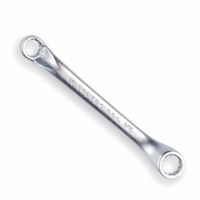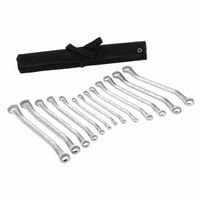Call +(254) 703 030 000 / 751 483 999 / 721 704 777
- Home
- Tools
- Hand Tools
- Wrenches
- Box End Wrenches Sets
.....Read More
Frequently Asked Questions
What is a box-end wrench used for?
A box-end wrench is a hand tool used for tightening or loosening nuts and bolts. It features a closed loop (or "box") at one or both ends, which fits snugly over the hexagonal or square heads of fasteners. This design provides a secure grip and minimizes the risk of slipping, making it ideal for applying significant torque. The box-end wrench is particularly useful in situations where fasteners are tightly secured or corroded, as its design allows for better leverage and control compared to open-end wrenches.
Box-end wrenches are often used in automotive repair, machinery maintenance, and construction. They are available in various sizes to match different fastener dimensions, and some models have offset handles to provide clearance over obstructions. Double box-end wrenches have two different-sized ends, offering versatility in a single tool. The closed-loop design also helps prevent rounding off the edges of fasteners, preserving their integrity for future use.
In summary, a box-end wrench is an essential tool for securely gripping and turning fasteners, providing efficiency and safety in various mechanical and construction tasks.
How does a ratcheting box-end wrench work?
A ratcheting box-end wrench is a hand tool designed to tighten or loosen nuts and bolts efficiently. It combines the features of a traditional box-end wrench with a ratcheting mechanism, allowing for continuous motion without needing to reposition the tool.
The wrench has a closed-loop, box-shaped end that fits snugly over the hexagonal head of a fastener. Inside this box-end, a ratcheting mechanism is housed. This mechanism typically consists of a gear and pawl system. The gear is attached to the inner circumference of the box-end, while the pawl is a small, spring-loaded lever that engages the gear teeth.
When the wrench is turned in one direction, the pawl locks into the gear teeth, allowing the wrench to apply torque to the fastener. This action tightens or loosens the fastener, depending on the direction of the turn. When the wrench is turned in the opposite direction, the pawl disengages from the gear teeth, allowing the wrench to move freely without turning the fastener. This free movement is what enables the ratcheting action, as it allows the user to reposition the wrench without removing it from the fastener.
Many ratcheting wrenches have a switch or lever that allows the user to change the direction of the ratcheting action, making it versatile for both tightening and loosening tasks. The ratcheting mechanism significantly reduces the need for lifting and repositioning the wrench, making it ideal for working in tight spaces or on fasteners that require multiple turns.
What sizes do box-end wrenches come in?
Box-end wrenches come in a variety of sizes to accommodate different bolt and nut dimensions. They are typically measured in either metric or SAE (Society of Automotive Engineers) units.
In metric sizes, box-end wrenches commonly range from 6mm to 32mm. Some of the most frequently used sizes include 8mm, 10mm, 12mm, 13mm, 14mm, 15mm, 17mm, 19mm, and 22mm. These sizes are often used in automotive and machinery applications, especially in countries where the metric system is standard.
In SAE sizes, which are measured in inches, box-end wrenches typically range from 1/4 inch to 1 1/4 inches. Common sizes include 3/8 inch, 7/16 inch, 1/2 inch, 9/16 inch, 5/8 inch, 11/16 inch, 3/4 inch, 13/16 inch, and 7/8 inch. These are widely used in the United States and other regions where the imperial system is prevalent.
Box-end wrenches are often sold in sets that cover a range of sizes, providing versatility for various tasks. Some sets may include both metric and SAE sizes, while others focus on one measurement system. Additionally, there are specialized box-end wrenches designed for specific applications, such as those with ratcheting mechanisms or offset handles, which may also come in a range of sizes.
Overall, the size selection of box-end wrenches is designed to meet the needs of different fastening tasks, ensuring compatibility with a wide array of bolt and nut sizes.
Are ratcheting box-end wrenches better than regular ones?
Ratcheting box-end wrenches offer several advantages over regular box-end wrenches, making them better in certain situations. The primary benefit is their ratcheting mechanism, which allows for continuous turning of a fastener without needing to remove and reposition the wrench. This feature is particularly useful in tight or confined spaces where there is limited room to maneuver. It increases efficiency and reduces the time required to complete a task.
Ratcheting wrenches also provide greater convenience and ease of use. They often have a smaller arc swing, meaning less movement is needed to engage the next tooth of the ratchet, which is beneficial in restricted areas. This can lead to less fatigue for the user, as the wrench requires less effort to operate.
However, regular box-end wrenches have their own advantages. They are typically more durable and can handle higher torque applications because they lack moving parts that can wear out or break. They are also generally less expensive, making them a cost-effective choice for basic applications.
In summary, ratcheting box-end wrenches are better for tasks requiring speed and efficiency in tight spaces, while regular box-end wrenches are preferable for high-torque applications and when durability and cost are primary concerns. The choice between the two depends on the specific needs of the task at hand.
How do you maintain box-end wrenches?
To maintain box-end wrenches, follow these steps:
1. **Cleaning**: After each use, wipe the wrenches with a clean cloth to remove dirt, grease, and debris. For stubborn grime, use a mild detergent and warm water. Dry thoroughly to prevent rust.
2. **Inspection**: Regularly inspect the wrenches for signs of wear, such as cracks, bends, or rounded edges. Replace any damaged wrenches to ensure safety and effectiveness.
3. **Lubrication**: Apply a light coat of machine oil or a rust-preventive spray to the wrenches to protect against corrosion. Focus on the box ends and any moving parts.
4. **Storage**: Store wrenches in a dry, cool place. Use a tool chest, pegboard, or wrench rack to keep them organized and prevent them from banging against each other, which can cause damage.
5. **Avoid Misuse**: Use the correct size wrench for the job to prevent rounding off nuts and bolts. Avoid using wrenches as hammers or pry bars, as this can damage the tool.
6. **Calibration**: For precision work, periodically check the calibration of your wrenches, especially if they are used frequently. This ensures accuracy and reliability.
7. **Environmental Protection**: If working in harsh environments, such as outdoors or in wet conditions, take extra precautions to clean and dry the wrenches immediately after use to prevent rust and corrosion.
8. **Professional Servicing**: For high-quality or specialized wrenches, consider professional servicing or calibration to maintain their precision and longevity.
By following these maintenance steps, you can extend the life of your box-end wrenches and ensure they remain effective and safe to use.
What materials are box-end wrenches made from?
Box-end wrenches are typically made from durable materials to withstand the torque and stress applied during use. The most common materials include:
1. **Chrome Vanadium Steel**: This is the most prevalent material used for box-end wrenches. It is an alloy steel that includes chromium and vanadium, which enhance strength, toughness, and resistance to wear and corrosion.
2. **Carbon Steel**: Some wrenches are made from high-carbon steel, which provides good hardness and strength. However, they may be more prone to rust if not properly coated or maintained.
3. **Stainless Steel**: Less common due to cost, stainless steel wrenches offer excellent corrosion resistance and are ideal for environments where moisture is a concern.
4. **Alloy Steel**: This is a broad category that includes various steel alloys designed to improve specific properties like strength, hardness, and resistance to wear and fatigue.
5. **Chrome Molybdenum Steel**: Often used for impact wrenches, this material is known for its high strength and ability to withstand heavy impacts.
6. **Titanium**: Rarely used due to high cost, titanium wrenches are lightweight and extremely strong, offering excellent corrosion resistance.
7. **Coatings and Finishes**: Many box-end wrenches are coated with chrome plating to enhance corrosion resistance and provide a smooth, easy-to-clean surface. Other finishes might include black oxide or nickel plating for additional protection and aesthetic appeal.
These materials and finishes ensure that box-end wrenches are durable, reliable, and suitable for a wide range of applications, from automotive repair to industrial maintenance.
Can box-end wrenches be used on all types of fasteners?
No, box-end wrenches cannot be used on all types of fasteners. Box-end wrenches are specifically designed for hexagonal (hex) or square fasteners, providing a snug fit around the fastener head. They are ideal for situations where a strong grip and high torque are needed, as they fully encircle the fastener, reducing the risk of slippage and rounding.
However, box-end wrenches are not suitable for fasteners with non-standard shapes, such as those with Torx, star, or spline heads. These fasteners require specialized tools designed to match their unique profiles. Additionally, box-end wrenches are not effective for fasteners located in tight or recessed spaces where the wrench cannot fully encircle the fastener head.
For fasteners with limited access, open-end wrenches, adjustable wrenches, or socket wrenches might be more appropriate. Furthermore, box-end wrenches are not suitable for fasteners that require a specific torque setting, as they do not have a built-in torque measurement capability like a torque wrench.
In summary, while box-end wrenches are versatile and effective for many standard fasteners, they are not universally applicable to all fastener types and situations.



